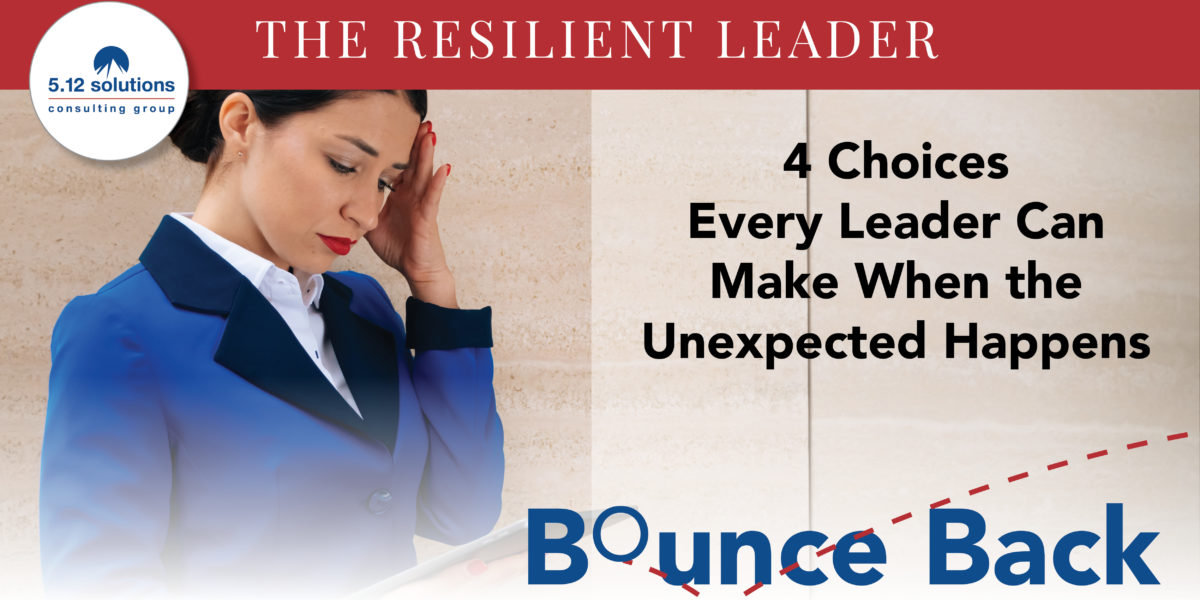We’ve been through so much this year – a global pandemic, a divisive political environment, weather calamities and economic uncertainty for so many.
Not to mention, all of the normal volatility, uncertainty, complexity and ambiguity of our normal workplace.
Resilience has turned out to be critical to successfully navigate today’s world.
But what is resilience?
There are several theories about the construct of resilience, and many differ in their definitions. However, they all have two components in common – the idea of adversity and positive adaptation.
We define resilience as the ability to face challenges and bounce back.
Being resilient doesn’t mean that you don’t experience stress or fear. It doesn’t mean that at times you may not become overwhelmed or even feel a sense of suffering.
All of that is part of the human experience.
The resilient person, team and even organization is able to reflect on an adverse situation and adapt to it positively.
The good news? Resilience can be learned. You can develop the capacity to withstand and even thrive through difficult times.
“Do not judge me by my success, judge me by how many times I fell down and got back up again.” – Nelson Mandela
Why Is Resilience Important?
Resilience is a critical skill because it enables us to navigate our unpredictable world. If COVID-19 has done anything, it has accelerated changes that were already underway. According to a recent McKinsey article, the adoption of digitization, automation and remote work are just a few examples of how imminent changes were accelerated.
Resilience enables us to deal with our constantly evolving world and come out on the other side in a more positive state than where we began.
Factors Influencing Resilience
A number of factors contribute to resilience and can be broadly categorized in areas that we cannot control and areas that we can control.
We can’t control things like our genetics, our personality or where we were raised. We can’t control the weather, the political environment or how others will react.
However, there are many we can control, like the meaning we attach to an event, our emotional responses to a situation and how we respond to others and our environment.
We have noticed in our leadership and executive coaching work over the past 20 years that highly resilient people focus on four key choices that are within their control.
The RESIL Model: 4 Key Choices
Choice #1: Refocus – What Are the Facts of the Situation?
Resilient people choose to confront the facts of their reality. They see the world for what it is without exaggerating or distorting the situation. They also don’t sugar coat their experience because they know that positive thinking alone can be a form of avoidance.
Choice #2: Embrace an Empowering Mindset – What Do You Believe About the Situation?
Resilient people know that the meaning they attach to the situation is completely within their control. Take for example the loss of a job, a situation that cuts deeply into our individual identity. Where some people might see loss and hopelessness, resilient people may find opportunity and a chance to grow. By engaging in new perspectives and challenging their own thinking, resilient people choose to draw an empowering meaning from their current situation instead of letting the meaning be dictated to them.
Choice #3: Strategize and Act – What Actions Will You Choose? After facing the facts and creating new meaning behind the situation, resilient people realize that they can also control how they move forward. They envision a new future, find purpose in their path and create a rallying cry for both themselves and those around them. Resilient people choose to spend their time and energy on actions that lie within their realm of control.
Choice #4: Learn and Repeat – What Insights Will You Gain? Resilient people choose to learn from their actions. They build support systems to help bolster their chance of winning and they pay attention to not only the outcome of their actions but also to their own emotions, building self-awareness and interpersonal agility.
Build Your Resilience
The RESIL model is a circular and never-ending process and it assumes that we are all the captain of our own ship. Of course, in life there are things that are unfair and out of our control, but resilient leaders choose what to focus on, how to think about the situation, the actions they will take and what they will learn.
Download our RESIL toolkit below to help apply the concepts in this post. Stay tuned for more resources over the next three months throughout our Bounce Back series, designed to help you persevere through these challenging times.

